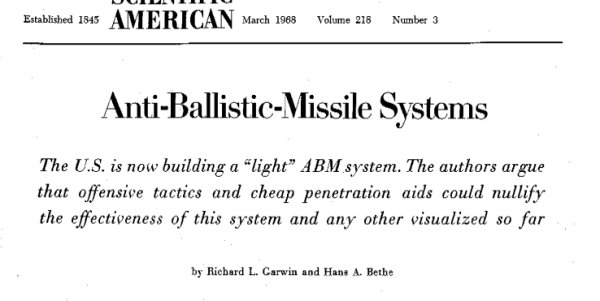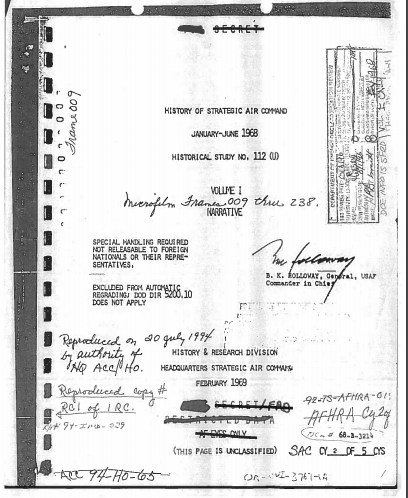Declassified SAC History Indicates Massive Nuclear Strikes Planned Against Soviet Anti-Missile Sites During Cold War
Missile Defenses Then and Now
A declassified Strategic Air Command History from 1968, recently cited in former SAC commander-in-chief Lee Butler’s memoirs, sheds light on the role of anti-ballistic missile defenses in national policies and international relations. According to the SAC history, in the late 1960s, SAC targeted over 100 Minuteman missiles, over 10 percent of the ICBM forces, on Soviet ABM sites lest Soviets disrupt a U.S. nuclear strike in the event of the outbreak of general war. The assignment of large numbers of nuclear warheads against Soviet ABM sites would characterize Cold War U.S. nuclear planning.
Missile defense systems were divisive issues during the Cold War and have unsettled U.S.-Russian relations during the years that followed. Besides Russia’s invasion of the Ukraine and the tensions over NATO enlargement, one reason why arms control talks with Russia and China have foundered is that both countries object to U.S. ballistic missile defense (BMD) programs. Moscow and Beijing see BMD as a threat that weakens their nuclear strike capabilities. For example, the Russians refuse to participate in follow-on New START talks unless missile defenses are an element of the negotiation, among other considerations.[i] Voicing historic Russian anxieties about missile defenses, President Putin has argued that U.S. programs undermine the strategic balance, the threat of mutual destruction that “ensured and guaranteed peace on the planet, sparing us from major military conflict over the last 70 years.” When the Bush administration unilaterally withdrew from the ABM Treaty in 2002, Putin saw that as “major blow” to the strategic balance leaving him no recourse except to “improv[e] Russia’s offensive missiles in order to improve the balance.” [ii]
A roughly parallel situation existed in the late 1960s, but in reverse, when the U.S. military saw the Soviet Union’s developing anti-ballistic missile (ABM) system as a potential threat to U.S. deterrence. The Soviet Union had been moving ahead in deploying a network of radars and nuclear-armed interceptors for destroying incoming missiles from different directions. From the Soviet perspective of those days, missile defense was “moral” while nuclear offense was “immoral.” To offset a perceived Soviet advantage the U.S. government was trying to catch up, developing what became known successively, as Nike-X, Sentinel, and then Safeguard ABM systems. The emerging ABM competition could exacerbate the ICBM race that had begun in the late 1950s. An interest in avoiding that provided powerful impetus to Moscow for the strategic arms limitation talks that began in late 1969.
Whatever arms control diplomacy accomplished, the U.S. Air Force saw the Soviet ABM system as a threat to be destroyed if war broke out. U.S. nuclear plans during the Cold War posited massive attacks on ABM systems as opening moves in general nuclear war. This remained true after the ABM Treaty (1972) because it left the Soviets the option, which they implemented, of defending Moscow, the “National Command Authority,” with a 100-interceptor anti-missile defense. In his recently published memoir, General Lee Butler recounted a briefing during 1991 on targeting plans against Soviet ABM complexes that he had received after he had become Commander-in-Chief of the Strategic Air Command and Director of the Joint Strategic Target Planning Staff:
I could hardly believe what I was hearing. Scores of thermonuclear warheads raining down on the periphery of Moscow, creating a holocaust of destruction and radioactive debris whose effects were beyond calculation, locally or globally. Had I been more familiar with the voluminous Strategic Air Command histories, specifically page 300 of the now unclassified/FOIA edition covering January-June, 1968, I would not have been caught so offguard – it made quite clear the scope of attack planning going back to the dawn of the Moscow ABM system.
When General Butler received this briefing, 69 nuclear warheads alone would have rained down on the new Puskhino (Don 2N) ABM battle management radar, over and above the numbers of warheads slated against other missile defenses, according to former SAC officer and Princeton University research scholar Bruce Blair. The declassified SAC history (see page 300 of excerpt, transcript attached owing to poor quality of original) that General Butler cites shows how massive the earlier strike plans were (besides providing valuable background on the launch-on-warning posture). As of early 1968, more than a 100 Minuteman ICBMs and an unspecified number of Polaris missiles would have targeted the ABM system. Some of them could have hit the Dnestr “Hen House” early warning radars, deployed on the Soviet Union’s periphery, for detecting incoming missiles. Others would have targeted the “Tallin” air defense system deploying SA-5 surface-to-air missiles located in Estonia. Most of the Minutemen may have targeted the ABM radars and interceptors surrounding Moscow, the Dunay “Dog House” and Try Add, which tracked incoming missiles and guided the “Galosh” ABM interceptors to their targets.[iii] As Butler observed, the impact of the detonations would have been “a holocaust of destruction and radioactive debris.”
 That SAC was devoting 10 percent of its ICBM force to destroying Soviet ABMs indicated the high priority that it gave to that target system. Yet, U.S. strategic planners were well aware that counter-measures were available that would make it possible for U.S. Minutemen warheads to evade Soviet ABMs and strike military or urban-industrial target systems. Spurgeon Keeny, then on the National Security Council staff, wrote to national security adviser Walt Rostow in May 1966 that the Moscow ABM system “would not be particularly effective in the defense of Moscow and would have only a small perturbation on our over-all war plans.” According to Keeny, a “very small number of missiles” using chaff and decoys “could probably overwhelm the system.” Whatever U.S. planners thought of Soviet ABM capabilities at the time, it eventually became known that the Soviet ABM system of the late 1960s was “hopelessly inadequate” because it was geared to defending against only six or seven incoming ICBMs.[iv] At the same time that SAC was making its targeting plans against the Soviet ABM, Hans Bethe and Richard Garwin published a major article on “Anti-Ballistic Missile Systems” in the Scientific American (March 1968) that explained in “general terms, using nonsecret information, the techniques an enemy could employ at no great cost to reduce the effectiveness of an ABM system.” The techniques included decoys, chaff and jammers to confuse the adversary’s radar and radar blackouts caused by a nuclear explosion. As well-known as those techniques were apparently U.S. war planners did not have enough confidence in them to re-assign the 100 Minutemen to another mission.
That SAC was devoting 10 percent of its ICBM force to destroying Soviet ABMs indicated the high priority that it gave to that target system. Yet, U.S. strategic planners were well aware that counter-measures were available that would make it possible for U.S. Minutemen warheads to evade Soviet ABMs and strike military or urban-industrial target systems. Spurgeon Keeny, then on the National Security Council staff, wrote to national security adviser Walt Rostow in May 1966 that the Moscow ABM system “would not be particularly effective in the defense of Moscow and would have only a small perturbation on our over-all war plans.” According to Keeny, a “very small number of missiles” using chaff and decoys “could probably overwhelm the system.” Whatever U.S. planners thought of Soviet ABM capabilities at the time, it eventually became known that the Soviet ABM system of the late 1960s was “hopelessly inadequate” because it was geared to defending against only six or seven incoming ICBMs.[iv] At the same time that SAC was making its targeting plans against the Soviet ABM, Hans Bethe and Richard Garwin published a major article on “Anti-Ballistic Missile Systems” in the Scientific American (March 1968) that explained in “general terms, using nonsecret information, the techniques an enemy could employ at no great cost to reduce the effectiveness of an ABM system.” The techniques included decoys, chaff and jammers to confuse the adversary’s radar and radar blackouts caused by a nuclear explosion. As well-known as those techniques were apparently U.S. war planners did not have enough confidence in them to re-assign the 100 Minutemen to another mission.
Missile Defenses: From Bush II to Obama
In 2007, the Federation of American Scientists’ Hans M. Kristensen first brought this SAC history to light in a fascinating Web post that raised important questions about the role of missile defenses in nuclear strategy and the Bush administration’s plans for a missile defense system in Eastern Europe.[v] While President Obama continued the ballistic missile defense system based in Ft. Greely in Alaska, he canceled the Eastern European program leaving in its place as a part of his the Phased Adaptive Approach, a land-based version of the Aegis shipborne BMD system, ostensibly designed to protect U.S. forces deployed in Western Europe from a future Iranian missile threat. So far that has involved Aegis Ashore deployments in Romania and ground breaking for a similar installation in Poland. The Navy has plans to deploy hundreds of Aegis/SM-3 interceptors on ships in the coming years:
On the East Asian front, the United States and South Korea have agreed on plans to base an Army ballistic missile defense system, terminal high altitude area defense (THAAD), although it faces Korean domestic opposition. The Japanese Government has also expressed interest in deploying the system. An element in the Obama administration’s support for THAAD in South Korea was its possible utility to strengthening the Nuclear Nonproliferation Treaty system by discouraging local interest in acquiring indigenous nuclear deterrents against the North.
How THAAD and Aegis fare in the new administration will probably depend on the balance between Secretary of Defense Mattis’s priorities, strong Republican support for expanding missile defenses, and the new President’s interest in accommodation with Russia. If missile defenses go forward, it is worth keeping in mind that the same types of countermeasures that have available since the 1960s are likely to render them ineffective. For example, with respect to possible THAAD deployments in South Korea, Jeffrey Lewis has argued that North Korea is developing its own capabilities against them. “There are many countermeasures available to North Korea to defeat missile defenses,” such as the solid-fueled KN-11 missile, which could be used for submarine-launched ballistic missiles that could defeat THAAD if launched in salvo and behind the radars. [vi] That would be the most costly one; exoatmospheric decoys would be far less expensive.
The Chinese and the Russian governments have respectively criticized THAAD in South Korea and Aegis Ashore in Romania and Poland. The U.S. has denied that these systems have any mission other than defense against Iran and North Korea, but Beijing has declared that the THAAD radar is a threat to its security interests, just as Putin has criticized Aegis deployments in Eastern Europe.[vii] In his recent speech Putin mentioned countermeasures: “ weapons that are designed to penetrate ballistic missile defense systems,” and Chinese military experts recognize their relevance to thwarting BMD.[viii] It is likely that military planners in Beijing and Moscow put U.S. missile defenses on their target lists just as SAC planners and their successors targeted Soviet and Russian ABMs. As Hans Kristensen put it, “all the major nuclear weapon states insist that they must hedge against an uncertain future and continue to adjust their strike plans against potential adversaries that have weapons of mass destruction.” As long as such conditions obtain, the U.S.’s BMD systems may remain an element in the nuclear disarmament stalemate.
* Thanks to Frank von Hippel and Ted Postol for inspiring this posting and thanks to Jordan Pyers for the transcription.
[i] Heather Williams, “Russia Still Needs Arms Control,” Arms Control Today, January/February 2016, https://www.armscontrol.org/ACT/2016_0102/Features/Russia-Still-Needs-Arms-Control.
[ii] “Meeting with Heads of International News Agencies, June 17 2016, St Petersburg,” http://en.special.kremlin.ru/events/president/transcripts/52183.
[iii] For details on Soviet ABM defenses, see Stephen Zaloga, The Kremlin’s Nuclear Sword (Washington, D.C.: Smithsonian Institution, 2002), 123, 125-126, and 163-169.
[iv] Ibid., 126.
[v] Hans Kristensen followed up this blog entry with Matthew G. McKinzie and Robert S. Norris in “The Protection Paradox,” The Bulletin of the Atomic Scientists 60 (2004).
[vi] Jeffrey Lewis, “KN-11 and Thaad,” Armscontrolwonk.com, http://www.armscontrolwonk.com/archive/1201857/kn-11-and-thaad/.
[vii] Kingston Reif and Kelsey Davenport, “South Korea to Deploy U.S. Defense System,” Arms Control Today, September 2016 https://www.armscontrol.org/ACT/2016_09/News/South-Korea-to-Deploy-US-Defense-System; Kingston Reif, “Romania Missile Defense Site Activated,” Arms Control Today, June 2016, https://www.armscontrol.org/ACT/2016_06/News/Romania-Missile-Defense-Site-Activated.
[viii] Work on countermeasures began in the former Soviet Union during the 1950s, see Zaloga, The Kremlin’s Nuclear Sword, at 123. For perspective on countermeasures and the missile defense debate generally, see Michael Krepon, “Ritualized Anxieties over BMD,” Armscontrolwonk.com, http://www.armscontrolwonk.com/archive/403783/ritualized-anxieties-over-bmd.



When the Americans said, “Better dead than red,” I guess they weren’t kidding. They are still trying to figure out how to win a nuclear war against Russia and China simply because they won’t bend the knee and allow them to conquer every corner of the globe.